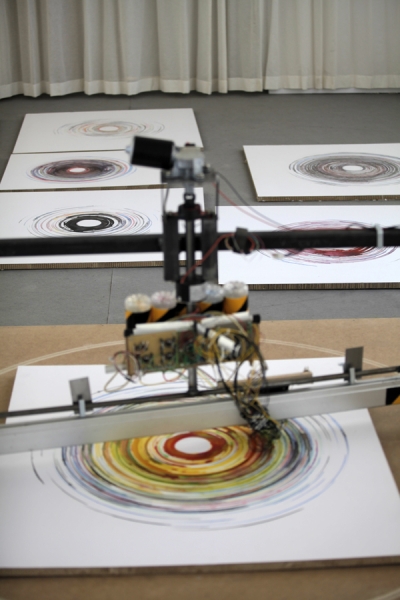2010 / Metaphone Apparatus
The only static imaginable is life, is development - is motion... Jean Tinguely in Kunst ist Revolte, National Zeitung Basel, 1967
Metaphone - the art project is consisting of an interactive apparatus, painting technique, and sonic art. In first phase pictorial artworks are produced from sound: audio frequency is colour, volume is radius; second part of the project is to listen sound back from the picture - this part is still under development. Additionally, there is a possibility to work with video and photography, for live performances and for exhibition format.
The project is dedicated to the synthesis of colour and sound, from Igor Stravinsky's relation of rhythm to colour, to Jean Tinguely's machinery and linked to his Métamatic machine works.
Querying whether authorship is shared between artist, observer and artwork, where contemporary art practices such as mixing, open-source, reflection, interaction and collaboration have become a norm. Generative process, interdisciplinary and wide range of traditional and new media are predominant for the Metaphone project.
First exhibited at Open Studios on White Balcony in Royal Institute of Art in Stockholm, Sweden. Process based studio work was implemented and numerous pictorials from sound were produced with water color, ink and acrylics on paper. Environmental Mandala - the project so-called according to the first show visitors.
Dimensions of the paintings are around 2m x 2m, but also smaller like pocket-book size.
Other machines with diverse patterns like spirograph will come out soon and join Metaphone family. We hope for great continuation!
Metaphone.net is on a way to spread the sonic visual.
Visit the artist's portoflio for more pictures on the project: www.simbelis.com
Modules
Metaphone #01 - interaction through the audio sensor microphone.
In the first phase of the project (2011), the machine has produced pictorial artworks from sound input: audio frequency got mapped into colour scale, the audio volume was affecting the radius of the painting; secondly, the creation of the soundscape from visuals was executed: the algorithm was translating colour scale of the painting back into audible scape.
Metaphone #02 - drawings produced from EEG sensor.
Additional electroencephalographic (EEG) set receives participant’s brain impulses emission, at the same, the Metaphone machine is drawing pictorials and monitoring sounds from the sensor. Listening of the participant’s brain signals being amplified and exposed publicly also getting them drawn on paper is a potential of such. Personal neuro-sites and para-states have been audio-visualized in 2012.
Metaphone #03 - interaction using bio-sensing technology.
The Metaphone machine collects the participant’s bio-data, Galvanic Skin Response (GSR) and Heart Rate (HR), creating a process of movement, painting, and sound. The machine behaves in machine-like, aesthetically evocative ways: a shaft on two large wheels rotates on the floor, carrying paint that is dripped onto a large sheet of aquarelle paper on the floor according to bio-sensor data. A soundscape rhythmically follows the bio-sensor data but also has its own machine-like sounds. This bio-sensing module was implemented in 2013. In essence, the Metaphone is constituted by three main elements, namely, (1) a bio-ball that fits in the palm of the hand, picking up on the biological signals of the participant, converting it into a stream of bio-data transmitted wirelessly to the rest of the machine, (2) a drawing machine that converts sound as input into drawings on a large aquarelle paper underneath it, (3) a sonic core that both converts the bio-data into sounds (internal, not heard), that the drawing machine can understand, and makes it audible to the participants. Several research papers were written about this module.
Metaphone #04 – the blowing sensor and control panel.
Exploring various ways of the machine influencing participants, interaction and painting technique, the fourth version of the Metaphone was constructed. Blowing sensor combined with a control panel with knobs continues questioning interaction paradigm between human and machine and also raising questions on aspects of control. By blowing the participants feed off the machine with power and then control several parameters of the machine: the amount of each colour, the speed of the moving cart and the frequency of opening valves. Metaphone #04 was exhibited at ISEA in Dubai, 2014.
And finally the Digital Metaphone version #05 questions liquidity of light in interactive experiences drawing on sensed data with light and sonics.





















